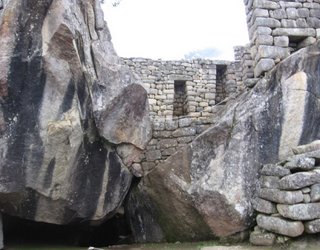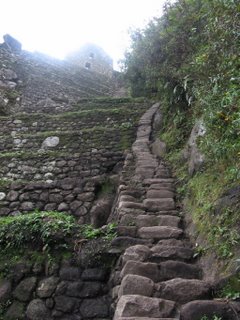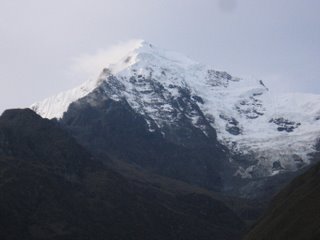Machupicchu - 4th day
But the best was saved for last, the next morning we were up at 5am to catch the bus to Machupicchu (means Old Mountain). When we arrive the entire mountain top was shrouded in mist. Upon entering the ruins, we realised that we had stepped through a portal into history and were lost in the obscuring mists of time that only granted us tantalising glimpses of the past. Proceeding like detectives, we slowly followed a trail of clues - at first just a ghost of a wall and the promise of a terrace, then a spectral wraith of vapour leads us to a groove which turns out to be part of a channel drawing water from a fountain set in the side of a great granite wall - after a few yards the wall gives way to a trail of steps ascending to a grand chamber where a halo of suffused light draws us to a doorway exiting onto another rising flight of steps strewn with foggy cobwebs – advancing deeper into the mysterious maze the mist dissolves to unveil a magnificent temple lauding over an ethereal realm of clouds with paths leading down into a great gloom. Then, just as we’re starting to wonder whether we’re trapped in Escher’s never-ending Ascending and Descending Lithograph, the gods could not keep their secret any longer and release a pent-up breath, rolling back the mists of time to reveal an entire town dramatically perched on the top of a ridge between two spectacular peaks. If Zeus could have chosen his home on top of the world, this would have been it. What an incredible site - mist everywhere, large beautiful mountains surrounding and protecting this concealed treasure. The ruins were spectacular, huge terraces, rocks, waterways, temples to Condor, Puma and Serpent. It is many things: majestic, mysterious, magnificent and more – words simply cannot do it justice.
To get an aerial view of Machupicchu we climbed up the nearby Wayna Picchu peak. The trail up was incredibly steep and at times we had to haul ourselves up on ropes. On the way down some of the narrow descents were so sheer we had to put our backpacks in front of us to avoid them hitting the slope behind us. From high above, the scale and beauty of the citadel becomes more apparent and we could only marvel at its wonder.
The ruins themselves are but clues to even greater mysteries. Because the Inca’s did not write nor use detailed hieroglyphics, much is left to speculation and imagination. While they did use obscure symbols, no “Rosetta Stone” has been found and as such, these symbols have yet to be deciphered. What is evident is that Machupicchu is an entire citadel with military, astrological, religious, residential and storage sections containing a number of temples and palaces and numerous houses, storage buildings and terraces. Some believe it was a palace but more recent research suggests it also served as a sort of a university. The reason why the Incas abandoned Machupicchu is unknown. There are several theories: a plague; a great fire; or fear of being discovered by Spanish. Interestingly, Hiram Bingham, the American archaeologist that rediscovered Machupicchu, said he found no gold on the site, only silver. However, more recent excavations on the site have curiously uncovered gold artefacts, which raises some questions. Did Hiram Bingham find some of the gold and secret it away or was it removed? It is generally believed that the Incas retreated deep into the jungle. Some archaeologists still speculate about the possibility of another undiscovered site in the jungle that may be the fabled city of Eldorado containing the lost Inca gold. We left that mystery unsolved and instead settled for a warm bath and soft bed.
Even though the trail was hard, it was one of the most rewarding and incredible experiences we’ve had. The natural beauty, magnificent ruins and rich history, infused with the mystery of the unknown, combine to make the trail such a rich experience.









0 Comments:
Post a Comment
<< Home